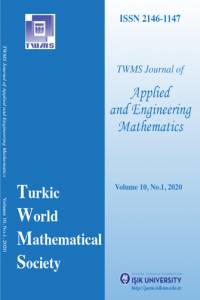COOPERATIVE TWO-STAGE NETWORK DEA: A GOAL PROGRAMMING APPROACH
In this study, we present a two-stage data envelopment analysis method dealing with eciency evaluation of decision making units with network structure. The key point of the study is that the suggested model optimizes the Black-Box and stages eciencies simultaneously with the aim of achieving the smallest possible gap between the aspiration levels.
___
- Charnes, A., Cooper, W. W. and Rhodes, E., (1978), Measuring the efficiency of decision making units, Eur. J. Oper. Res., 2 (6), pp. 429444.
- Chen, Y., Cook, W. D., Li, N. and Zhu, J., (2009), Additive efficiency decomposition in two-stage DEA. Eur. J. Oper. Res., 196(3), pp. 11701176.
- Despotis, D. K., Koronakos, G. and Sotiros, D. (2015), A Multi-objective Programming Approach to Network DEA with an Application to the Assessment of the Academic Research Activity. Procedia Comput. Sci., 55, 370379.
- Despotis, D.K., Koronakos, G. and Sotiros, D. (2016), Composition versus decomposition in two-stage network DEA: a reverse approach. J. Prod. Anal., 45(1), pp. 71-87.
- Despotis, D.K., Sotiros, D. and Koronakos, G. (2016), A network DEA approach for series multistage processes, Omega, 61, 35-48.
- Fre, R. (1991), Measuring Farrell Efficiency for a Firm with Intermediate Inputs. Academe. Econ. Pap., 19, 329340.
- Farrell, M. J. (1957), The Measurement of Productive Efficiency. J. R. Stat. Soc. Ser. A-G, 120(3), pp. 253.
- Guo, C., Shureshjani, R.A., Foroughi, A.A. and Zhu, J. (2017), Decomposition weights and overall efficiency in two-stage additive network DEA. Eur. J. Oper. Res., 257, 896-906.
- Kao, C. (2014), Efficiency decomposition for general multi-stage systems in data envelopment analysis. Eur. J. Oper. Res., 232(1), pp. 117124.
- Kao, C. and Hwang, S.-N. (2008), Efficiency decomposition in two-stage data envelopment analysis: An application to non-life insurance companies in Taiwan. Eur. J. Oper. Res., 185(1), pp. 418429.
- Kao, H.Y., Chan, C.Y. and Wu, D.-J. (2014), A multi-objective programming method for solving network DEA. Appl. Soft Comput., 24, 406413.
- Li, Y., Chen, Y., Liang, L. and Xie, J. (2012), DEA models for extended two-stage network structures. Omega, 40(5), pp. 611618.
- Liang, L., Cook, W. D. and Zhu, J. (2008), DEA models for two-stage processes: game approach and efficiency decomposition. Nav. Res. Log., 55, 64353.
- Liu, F. H. F. and Hsuan Peng, H. (2008).Ranking of units on the DEA frontier with common weights. Comput. Oper. Res., 35(5), pp. pp. 16241637.
- Seiford, L. M. and Zhu, J. (1998), On alternative optimal solutions in the estimation of returns to scale in DEA. Eur. J. Oper. Res., 108(1), pp. pp. 149152.
- Wang, C. H., Gopal, R. D. and Zionts, S. (1997), Use of Data Envelopment Analysis in assessing Information Technology impact on firm performance. Ann. Oper. Res., 73(0), pp. pp. 191213.
- Yu, Y. and Shi, Q. (2014), Two-stage DEA model with additional input in the second stage and part of intermediate products as final output. Expert Syst. Appl., 41(15), pp. pp. 65706574.
- ISSN: 2146-1147
- Başlangıç: 2010
- Yayıncı: Turkic World Mathematical Society
